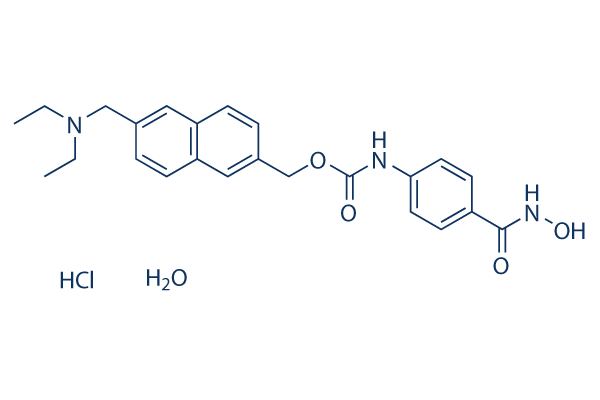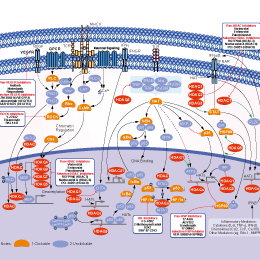
- Bioactive Compounds
- By Signaling Pathways
- PI3K/Akt/mTOR
- Epigenetics
- Methylation
- Immunology & Inflammation
- Protein Tyrosine Kinase
- Angiogenesis
- Apoptosis
- Autophagy
- ER stress & UPR
- JAK/STAT
- MAPK
- Cytoskeletal Signaling
- Cell Cycle
- TGF-beta/Smad
- DNA Damage/DNA Repair
- Compound Libraries
- Popular Compound Libraries
- Customize Library
- Clinical and FDA-approved Related
- Bioactive Compound Libraries
- Inhibitor Related
- Natural Product Related
- Metabolism Related
- Cell Death Related
- By Signaling Pathway
- By Disease
- Anti-infection and Antiviral Related
- Neuronal and Immunology Related
- Fragment and Covalent Related
- FDA-approved Drug Library
- FDA-approved & Passed Phase I Drug Library
- Preclinical/Clinical Compound Library
- Bioactive Compound Library-I
- Bioactive Compound Library-Ⅱ
- Kinase Inhibitor Library
- Express-Pick Library
- Natural Product Library
- Human Endogenous Metabolite Compound Library
- Alkaloid Compound LibraryNew
- Angiogenesis Related compound Library
- Anti-Aging Compound Library
- Anti-alzheimer Disease Compound Library
- Antibiotics compound Library
- Anti-cancer Compound Library
- Anti-cancer Compound Library-Ⅱ
- Anti-cancer Metabolism Compound Library
- Anti-Cardiovascular Disease Compound Library
- Anti-diabetic Compound Library
- Anti-infection Compound Library
- Antioxidant Compound Library
- Anti-parasitic Compound Library
- Antiviral Compound Library
- Apoptosis Compound Library
- Autophagy Compound Library
- Calcium Channel Blocker LibraryNew
- Cambridge Cancer Compound Library
- Carbohydrate Metabolism Compound LibraryNew
- Cell Cycle compound library
- CNS-Penetrant Compound Library
- Covalent Inhibitor Library
- Cytokine Inhibitor LibraryNew
- Cytoskeletal Signaling Pathway Compound Library
- DNA Damage/DNA Repair compound Library
- Drug-like Compound Library
- Endoplasmic Reticulum Stress Compound Library
- Epigenetics Compound Library
- Exosome Secretion Related Compound LibraryNew
- FDA-approved Anticancer Drug LibraryNew
- Ferroptosis Compound Library
- Flavonoid Compound Library
- Fragment Library
- Glutamine Metabolism Compound Library
- Glycolysis Compound Library
- GPCR Compound Library
- Gut Microbial Metabolite Library
- HIF-1 Signaling Pathway Compound Library
- Highly Selective Inhibitor Library
- Histone modification compound library
- HTS Library for Drug Discovery
- Human Hormone Related Compound LibraryNew
- Human Transcription Factor Compound LibraryNew
- Immunology/Inflammation Compound Library
- Inhibitor Library
- Ion Channel Ligand Library
- JAK/STAT compound library
- Lipid Metabolism Compound LibraryNew
- Macrocyclic Compound Library
- MAPK Inhibitor Library
- Medicine Food Homology Compound Library
- Metabolism Compound Library
- Methylation Compound Library
- Mouse Metabolite Compound LibraryNew
- Natural Organic Compound Library
- Neuronal Signaling Compound Library
- NF-κB Signaling Compound Library
- Nucleoside Analogue Library
- Obesity Compound Library
- Oxidative Stress Compound LibraryNew
- Plant Extract Library
- Phenotypic Screening Library
- PI3K/Akt Inhibitor Library
- Protease Inhibitor Library
- Protein-protein Interaction Inhibitor Library
- Pyroptosis Compound Library
- Small Molecule Immuno-Oncology Compound Library
- Mitochondria-Targeted Compound LibraryNew
- Stem Cell Differentiation Compound LibraryNew
- Stem Cell Signaling Compound Library
- Natural Phenol Compound LibraryNew
- Natural Terpenoid Compound LibraryNew
- TGF-beta/Smad compound library
- Traditional Chinese Medicine Library
- Tyrosine Kinase Inhibitor Library
- Ubiquitination Compound Library
-
Cherry Picking
You can personalize your library with chemicals from within Selleck's inventory. Build the right library for your research endeavors by choosing from compounds in all of our available libraries.
Please contact us at [email protected] to customize your library.
You could select:
- Antibodies
- Bioreagents
- qPCR
- 2x SYBR Green qPCR Master Mix
- 2x SYBR Green qPCR Master Mix(Low ROX)
- 2x SYBR Green qPCR Master Mix(High ROX)
- Protein Assay
- Protein A/G Magnetic Beads for IP
- Anti-Flag magnetic beads
- Anti-Flag Affinity Gel
- Anti-Myc magnetic beads
- Anti-HA magnetic beads
- Magnetic Separator
- Poly DYKDDDDK Tag Peptide lyophilized powder
- Protease Inhibitor Cocktail
- Protease Inhibitor Cocktail (EDTA-Free, 100X in DMSO)
- Phosphatase Inhibitor Cocktail (2 Tubes, 100X)
- Cell Biology
- Cell Counting Kit-8 (CCK-8)
- Animal Experiment
- Mouse Direct PCR Kit (For Genotyping)
- New Products
- Contact Us
Givinostat (ITF2357)
Givinostat (ITF2357) is a potent HDAC inhibitor for maize HD2, HD1B and HD1A with IC50 of 10 nM, 7.5 nM and 16 nM in cell-free assays. Phase 2.

Givinostat (ITF2357) Chemical Structure
CAS No. 732302-99-7
Purity & Quality Control
Batch:
Purity:
99.77%
99.77
Givinostat (ITF2357) Related Products
Signaling Pathway
Biological Activity
| Description | Givinostat (ITF2357) is a potent HDAC inhibitor for maize HD2, HD1B and HD1A with IC50 of 10 nM, 7.5 nM and 16 nM in cell-free assays. Phase 2. | ||||||
|---|---|---|---|---|---|---|---|
| Features | An orally active, potent inhibitor of histone deacetylases (HDACs). | ||||||
| Targets |
|
| In vitro | ||||
| In vitro | In LPS-stimulated cultured human peripheral blood mononuclear cells (PBMCs), ITF2357 reduces the release of TNFα, IL-1α, IL-1β, and IFNγ, with IC50 of 10-25 nM, respectively. Using the combination of IL-12 plus IL-18, ITF2357 reduces IFNγ and IL-6 production with IC50 of 12.5-25 nM, independent of decreased IL-1 or TNFα. [1] ITF2357 is cytotoxic in multiple myeloma (MM) cell lines (RPMI8226, NCI-H929, JJN3, KMS 11, KMS 12, KMS 18, and KMS 20) and acute myelogenous leukemia (AML) cell lines (HL-60, THP-1, U937, KASUMI, KG-1, and TF-1), with IC50 of 200 nM. ITF2357 activates the intrinsic apoptotic pathway, upregulates p21 and downmodulates Bcl-2 and Mcl-1. ITF2357 inhibits the production of IL-6, VEGF, and IFNγ in mesenchymal stromal cells (MSCs) by 80-95%. [2] ITF2357 favors β-cell survival during inflammatory conditions. ITF2357 at concentrations of 25 and 250 nM increases islet cell viability, enhances insulin secretion, inhibits release of MIP-1α and MIP-2, reduces NO production and decreases apoptosis rates. [3] | |||
|---|---|---|---|---|
| Kinase Assay | Enzymatic Assay for HDAC Inhibitory Activity of Synthetic Compounds | |||
| The assay is performed by adding 100 μL substrate (2×105 cpm), 40 μL buffer (50 mM Tris-HCl, pH 8.0, 750 mM NaCl, 5 mM PMSF, 50% glycerol) and 95 μL distilled water to the crude cellular extract (5 μL). ITF2357 (50 μL) is added to test for HDAC inhibition. The mixture is incubated overnight at room temperature and the reaction quenched by adding 50 μL of a solution containing 259 μL 37% HCl and 28 μL acetic acid in 1 mL distilled water. The [3H]acetyl residues released from the substrate are separated by organic extraction with 600 μL of ethyl acetate, 200 μL of the organic phase is added to standard scintillation fluid, and radioactivity is measured by a beta-counter. Inhibition of HDACs is expressed as the concentration inhibiting 50% of the control activity (by comparing the radioactivity of the samples containing inhibitors to that of the control containing cellular crude extract alone). | ||||
| Cell Research | Cell lines | peripheral blood mononuclear cells (PBMCs) | ||
| Concentrations | 1 nM - 1 μM | |||
| Incubation Time | 24 hours | |||
| Method | After washing, the isolated PBMCs are resuspended in RPMI containing 5% FCS at 5×106/mL, added to a 50-mL conical polypropylene tube, and placed at 4 °C overnight. The PBMCs are resuspended the next morning and added to a 96-well flat microtiter plate (100 μL per well). ITF2357 is then added for inhibition studies, and the plates are incubated at 37 °C for 1 hour, after which the cells are stimulated with LPS or other stimulants in a final volume of 200 μL per well. The supernatants are removed after incubation at 37 °C for 24 hours, and frozen at -80 °C until assayed for cytokines. | |||
| Experimental Result Images | Methods | Biomarkers | Images | PMID |
| Western blot | SOD2(K68) / SOD2 / p53(K120) / p53(K382) / p53 / p65(K310) / p65 pERK / ERK / pJNK / JNK / pp38 / p38 PARP / Cleaved PARP / Pro-Caspase 7 / Cleaved caspase 7 / Pro-caspase 3 / Cleaved Caspase 3 CHK1 / p53 / p21 α-SMA / TGF-β1 / VEGF |

|
26217084 | |
| In Vivo | ||
| In vivo | ITF2357 (1-10 mg/kg) reduces LPS-induced serum TNFα and IFNγ by more than 50% in mice. Anti-CD3-induced cytokines are not suppressed by ITF2357 in PBMCs in the circulation in mice. In concanavalin-A-induced hepatitis, ITF2357 (1 or 5 mg/kg) significantly reduces liver damage. [1] ITF2357 (10 mg/kg) significantly prolongs survival of severe combined immunodeficient mice inoculated with the AML-PS in vivo passaged cell line. [2] In a mouse model of closed head injury (CHI), ITF2357 (10 mg/kg) improves neurobehavioral recovery, decreases neuronal degeneration, reduces lesion volume, and induces glial apoptosis. [4] | |
|---|---|---|
| Animal Research | Animal Models | Mice. For LPS induction of serum cytokines: BALB/c; for anti-CD3-induced cytokines: CD1; for concanavalin A (Con A)-induced acute hepatitis: BALB/c or C57Bl6. |
| Dosages | 0.01-50 mg/kg | |
| Administration | By gavage in 100 μL water. | |
| NCT Number | Recruitment | Conditions | Sponsor/Collaborators | Start Date | Phases |
|---|---|---|---|---|---|
| NCT05933057 | Recruiting | Duchenne Muscular Dystrophy |
Italfarmaco |
February 19 2024 | Phase 3 |
| NCT05860114 | Completed | Drug Drug Interaction |
Italfarmaco |
March 21 2022 | Phase 1 |
| NCT05845567 | Completed | Drug Drug Interaction |
Italfarmaco |
March 21 2022 | Phase 1 |
| NCT01901432 | Completed | Polycythemia Vera |
Italfarmaco |
October 2013 | Phase 1|Phase 2 |
Chemical Information & Solubility
| Molecular Weight | 475.97 | Formula | C24H27N3O4.HCl.H2O |
| CAS No. | 732302-99-7 | SDF | Download Givinostat (ITF2357) SDF |
| Smiles | CCN(CC)CC1=CC2=C(C=C1)C=C(C=C2)COC(=O)NC3=CC=C(C=C3)C(=O)NO.O.Cl | ||
| Storage (From the date of receipt) | |||
|
In vitro |
DMSO : 95 mg/mL ( (199.59 mM) Moisture-absorbing DMSO reduces solubility. Please use fresh DMSO.) Water : Insoluble Ethanol : Insoluble |
Molecular Weight Calculator |
|
In vivo Add solvents to the product individually and in order. |
In vivo Formulation Calculator |
||||
Preparing Stock Solutions
Molarity Calculator
In vivo Formulation Calculator (Clear solution)
Step 1: Enter information below (Recommended: An additional animal making an allowance for loss during the experiment)
mg/kg
g
μL
Step 2: Enter the in vivo formulation (This is only the calculator, not formulation. Please contact us first if there is no in vivo formulation at the solubility Section.)
% DMSO
%
% Tween 80
% ddH2O
%DMSO
%
Calculation results:
Working concentration: mg/ml;
Method for preparing DMSO master liquid: mg drug pre-dissolved in μL DMSO ( Master liquid concentration mg/mL, Please contact us first if the concentration exceeds the DMSO solubility of the batch of drug. )
Method for preparing in vivo formulation: Take μL DMSO master liquid, next addμL PEG300, mix and clarify, next addμL Tween 80, mix and clarify, next add μL ddH2O, mix and clarify.
Method for preparing in vivo formulation: Take μL DMSO master liquid, next add μL Corn oil, mix and clarify.
Note: 1. Please make sure the liquid is clear before adding the next solvent.
2. Be sure to add the solvent(s) in order. You must ensure that the solution obtained, in the previous addition, is a clear solution before proceeding to add the next solvent. Physical methods such
as vortex, ultrasound or hot water bath can be used to aid dissolving.
Tech Support
Answers to questions you may have can be found in the inhibitor handling instructions. Topics include how to prepare stock solutions, how to store inhibitors, and issues that need special attention for cell-based assays and animal experiments.
Tel: +1-832-582-8158 Ext:3
If you have any other enquiries, please leave a message.
* Indicates a Required Field
Tags: buy Givinostat (ITF2357) | Givinostat (ITF2357) supplier | purchase Givinostat (ITF2357) | Givinostat (ITF2357) cost | Givinostat (ITF2357) manufacturer | order Givinostat (ITF2357) | Givinostat (ITF2357) distributor







































